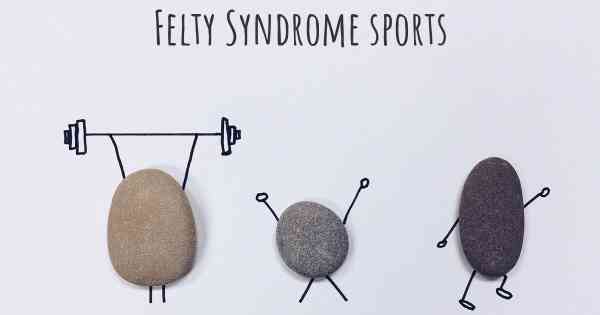Is it advisable to do exercise when affected by Felty Syndrome? Which activities would you suggest and how intense should they be?
See if it is advisable for people with Felty Syndrome to practice sports and which ones are the most recommended if you have Felty Syndrome

Felty Syndrome is a rare complication of rheumatoid arthritis (RA) characterized by the presence of an enlarged spleen and a low white blood cell count. It can cause symptoms such as fatigue, weakness, and joint pain. Engaging in regular exercise can be beneficial for individuals with Felty Syndrome, but it is important to approach it with caution and consult with a healthcare professional before starting any exercise program.
Exercise can provide several benefits for individuals with Felty Syndrome:
1. Improved joint function: Regular exercise can help improve joint mobility and reduce stiffness, which are common symptoms of Felty Syndrome. Low-impact exercises such as swimming, cycling, and walking can be particularly beneficial for joint health.
2. Increased muscle strength: Strengthening exercises can help improve muscle strength and stability, which can support the joints and reduce the risk of injuries. Resistance training using light weights or resistance bands can be incorporated into the exercise routine.
3. Enhanced cardiovascular health: Engaging in aerobic exercises like brisk walking, cycling, or using an elliptical machine can improve cardiovascular fitness, increase stamina, and boost overall health.
4. Weight management: Regular exercise can help maintain a healthy weight or achieve weight loss if necessary. Excess weight can put additional strain on the joints, exacerbating symptoms of Felty Syndrome.
5. Improved mood and mental well-being: Exercise releases endorphins, which are natural mood boosters. It can help reduce stress, anxiety, and depression commonly associated with chronic conditions like Felty Syndrome.
When it comes to the intensity and type of exercise, it is crucial to listen to your body and work within your limits. Start with low-impact exercises and gradually increase the intensity and duration as tolerated. It is recommended to aim for at least 150 minutes of moderate-intensity aerobic exercise or 75 minutes of vigorous-intensity exercise per week, spread across several days.
Here are some exercise recommendations for individuals with Felty Syndrome:
1. Walking: Walking is a low-impact exercise that can be easily incorporated into daily routines. Start with shorter distances and gradually increase the duration and pace.
2. Swimming: Swimming and water aerobics are gentle on the joints while providing a full-body workout. The buoyancy of water reduces the impact on joints, making it an excellent choice for individuals with Felty Syndrome.
3. Cycling: Cycling, either outdoors or on a stationary bike, is a low-impact exercise that can help improve cardiovascular fitness and joint mobility.
4. Yoga or Pilates: These activities focus on flexibility, strength, and balance. Modified poses and exercises can be tailored to accommodate individual needs and limitations.
5. Resistance training: Light resistance training using weights, resistance bands, or bodyweight exercises can help improve muscle strength and joint stability. It is important to use proper form and start with lighter weights.
Remember to warm up before exercising and cool down afterward to prevent injuries. If experiencing pain, swelling, or any unusual symptoms during or after exercise, it is essential to stop and consult with a healthcare professional.
In conclusion, exercise can be beneficial for individuals with Felty Syndrome, but it is important to approach it with caution and seek guidance from a healthcare professional. Low-impact exercises, such as walking, swimming, and cycling, along with resistance training and flexibility exercises like yoga or Pilates, can help improve joint function, muscle strength, cardiovascular health, and overall well-being. Start slowly and gradually increase the intensity and duration of exercise, listening to your body's signals along the way.








